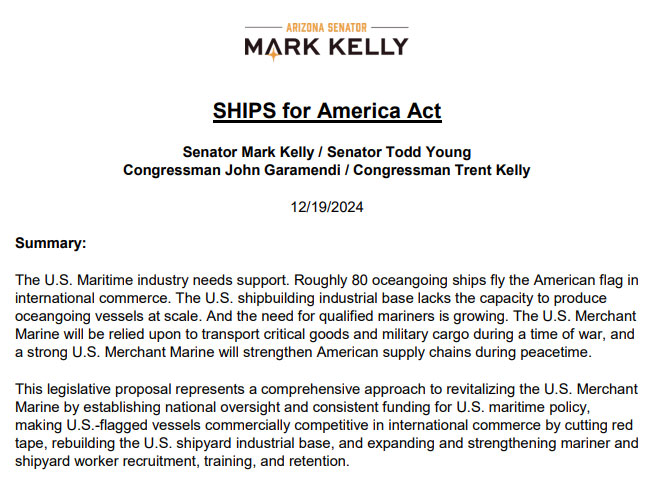

U.S. Shipping Act: 10% of China's imports must go on American ships
Recently, the U.S. Congress formally introduced the Ships for America Act, which would impose additional new tariffs on all imports shipped to the United States by Chinese-owned or Chinese-flagged ships. In addition, at least 10 percent of containerized cargo imported from China must be carried on U.S.-built, U.S.-crewed and U.S.-flagged ships.
This percentage will increase each year, starting in the fifth year after the law takes effect and increasing by 1% each year until it reaches 10% 14 years after the law takes effect. Importers who fail to comply face fines, which are calculated using the difference in freight rates between U.S. and foreign ships.
Lars Jensen, a shipping analyst, said the bill, if passed, would have a profound impact on U.S. imports from China, foreign container shipping companies and U.S. exporters. He pointed out that the bill not only increases the operating costs of Chinese shipping companies, but also affects shipping companies that have formed alliances or VSA with Chinese shipping companies, such as CMACGM and Evergreen.
In addition, the bill gives U.S.-flagged vessels preferential access to U.S. ports, especially in the event of congestion and disruption. At the same time, 100 percent of U.S. government cargo will be carried on U.S.-built, owned and crewed vessels, up from 50 percent currently.
It is worth noting that although the bill is still in the political deliberation stage, its passage is not certain. Even if it is passed, it will take several years for detailed implementation rules to be promulgated. However, the purpose of the bill has been made clear - to revitalize the U.S. merchant fleet and increase the cost of Chinese imports.

This percentage will increase each year, starting in the fifth year after the law takes effect and increasing by 1% each year until it reaches 10% 14 years after the law takes effect. Importers who fail to comply face fines, which are calculated using the difference in freight rates between U.S. and foreign ships.

Lars Jensen, a shipping analyst, said the bill, if passed, would have a profound impact on U.S. imports from China, foreign container shipping companies and U.S. exporters. He pointed out that the bill not only increases the operating costs of Chinese shipping companies, but also affects shipping companies that have formed alliances or VSA with Chinese shipping companies, such as CMACGM and Evergreen.
In addition, the bill gives U.S.-flagged vessels preferential access to U.S. ports, especially in the event of congestion and disruption. At the same time, 100 percent of U.S. government cargo will be carried on U.S.-built, owned and crewed vessels, up from 50 percent currently.
It is worth noting that although the bill is still in the political deliberation stage, its passage is not certain. Even if it is passed, it will take several years for detailed implementation rules to be promulgated. However, the purpose of the bill has been made clear - to revitalize the U.S. merchant fleet and increase the cost of Chinese imports.





